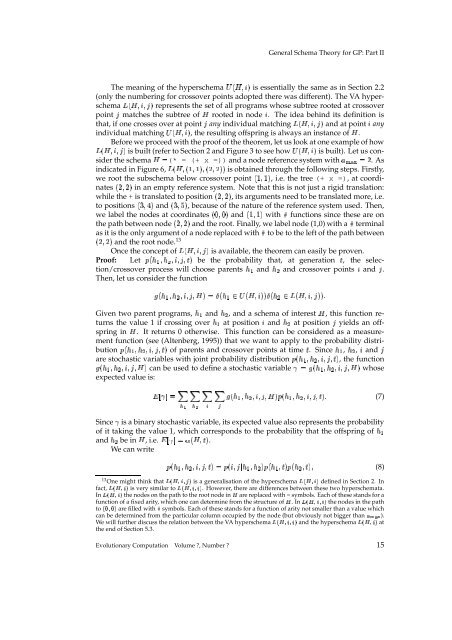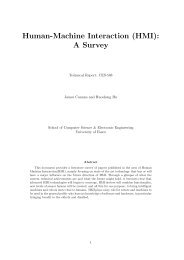General Schema Theory for Genetic Programming with Subtree ...
General Schema Theory for Genetic Programming with Subtree ...
General Schema Theory for Genetic Programming with Subtree ...
Create successful ePaper yourself
Turn your PDF publications into a flip-book with our unique Google optimized e-Paper software.
<strong>General</strong> <strong>Schema</strong> <strong>Theory</strong> <strong>for</strong> GP: Part II<br />
The meaning of the hyperschema ��¥ £¨§���� is essentially the same as in Section 2.2<br />
(only the numbering <strong>for</strong> crossover points adopted there was different). The VA hyperschema<br />
��¥ £¨§���§���� represents the set of all programs whose subtree rooted at crossover<br />
point � matches the subtree of £ rooted in node � . The idea behind its definition is<br />
that, if one crosses over at point � any individual matching ��¥ £�§���§���� and at point � any<br />
individual matching ��¥ £¨§���� , the resulting offspring is always an instance of £ .<br />
Be<strong>for</strong>e we proceed <strong>with</strong> the proof of the theorem, let us look at one example of how<br />
��¥ £¨§���§���� is built (refer to Section 2 and Figure 3 to see how ��¥ £¨§���� is built). Let us consider<br />
the schema £�� (* = (+ x =)) and a node reference system <strong>with</strong> ����������� . As<br />
indicated in Figure 6, ��¥ £¨§ ¥ ��§�����§ ¥ ��§������ is obtained through the following steps. Firstly,<br />
we root the subschema below crossover point ¥ ��§���� , i.e. the tree (+ x =), at coordinates<br />
¥ ��§���� in an empty reference system. Note that this is not just a rigid translation:<br />
while the + is translated to position ¥ ��§���� , its arguments need to be translated more, i.e.<br />
to positions ¥ ��§���� and ¥ ��§���� , because of the nature of the reference system used. Then,<br />
we label the nodes at coordinates ¥�� § � � and ¥ ��§���� <strong>with</strong> # functions since these are on<br />
the path between node ¥ ��§���� and the root. Finally, we label node (1,0) <strong>with</strong> a # terminal<br />
as it is the only argument of a node replaced <strong>with</strong> # to be to the left of the path between<br />
¥ ��§���� and the root node. 13<br />
Once the concept of ��¥ £�§���§���� is available, the theorem can easily be proven.<br />
Proof: Let � ¥�� � § � � §���§���§�©�� be the probability that, at generation © , the selection/crossover<br />
process will choose parents � � and � � and crossover points � and � .<br />
Then, let us consider the function<br />
��¥���� § ��� §���§���§�£���� � ¥���������¥ £¨§������ � ¥������¨��¥ £¨§���§��������<br />
Given two parent programs, � � and � � , and a schema of interest £ , this function returns<br />
the value 1 if crossing over � � at position � and � � at position � yields an offspring<br />
in £ . It returns 0 otherwise. This function can be considered as a measurement<br />
function (see (Altenberg, 1995)) that we want to apply to the probability distribution<br />
� ¥���� § ��� §���§���§�©�� of parents and crossover points at time © . Since ��� , ��� , � and �<br />
are stochastic variables <strong>with</strong> joint probability distribution � ¥���� § ��� §���§���§�©�� , the function<br />
��¥���� § ��� §���§���§�£�� can be used to define a stochastic variable ��� ��¥���� § ��� §���§���§�£�� whose<br />
expected value is:<br />
�������������������<br />
���<br />
�<br />
� � ��¥�� � § � � §���§���§�£���� ¥�� � § � � §���§���§�©���� (7)<br />
� Since is a binary stochastic variable, its expected value also represents the probability<br />
of it taking the value 1, which corresponds to the probability that the offspring of<br />
and ��� be £ in , i.e. ��� ¥ £¨§�©�� . �������<br />
We can write<br />
¥���� § ��� §���§���§�©����¦� ¥ ��§���� ��� § ��� ��� ¥���� §�©���� ¥���� §�©���§ (8)<br />
�<br />
13One might think ��������������� that is a generalisation of the ����������� hyperschema defined in Section 2. In<br />
����������� fact, is very similar ��������������� to . However, there are differences between these two hyperschemata.<br />
����������� In the nodes on the path to the root node � in are replaced <strong>with</strong> = symbols. Each of these stands <strong>for</strong> a<br />
function of a fixed arity, which one can determine from the structure � of . ��������������� In the nodes in the path<br />
��������� to are filled <strong>with</strong> # symbols. Each of these stands <strong>for</strong> a function of arity not smaller than a value which<br />
can be determined from the particular column occupied by the node (but obviously not bigger ������� than ).<br />
We will further discuss the relation between the VA ��������������� hyperschema and the ����������� hyperschema at<br />
the end of Section 5.3.<br />
Evolutionary Computation Volume ?, Number ? 15<br />
� �




